Small Purple Flowering Trees (With Pictures): Identification Guide
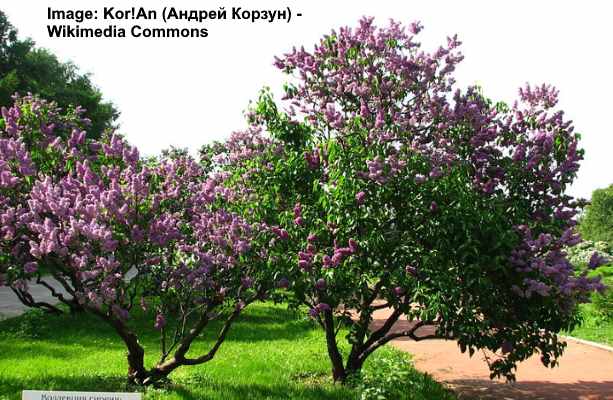
Small purple flowering trees can wonderfully enhance the charm of any compact space or limited area. When in full bloom, the purple blossoms create a captivating spectacle.
Some of the best small purple flowering trees the crape myrtle, common lilac, or purple flowering dogwood trees. These compact trees will elevate the appearance of your garden without taking up much space. These small purple flowering trees are not only visually appealing but are also low-maintenance, making them an excellent choice for small gardens or yards.
This article serves as a guide for identifying small purple flowering trees. Within this article, you’ll discover descriptions, pictures, and vital gardening details about the best small purple flowering trees.
Small Purple Flowering Trees (With Pictures)
Below, you’ll find a selection of the best small purple flowering trees for planting in your garden:
Chaste Tree (Vitex agnus-castus)
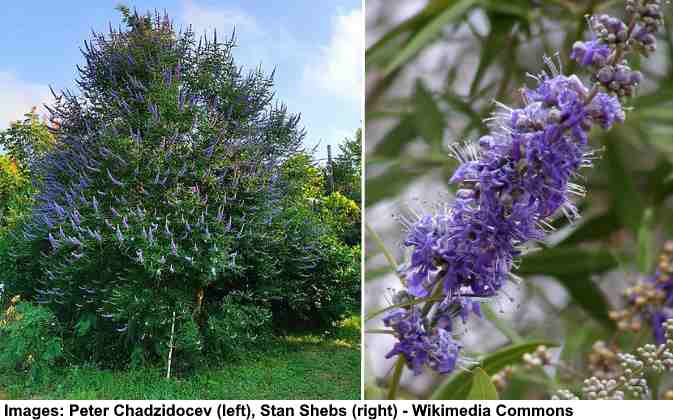
The chaste tree is a small, shrub-like tree known for its beautiful, upright clusters of fragrant purple flowers. In early summer, the tree’s vase-shaped, spreading canopy is covered with spiky, lilac flower clusters, creating a beautiful sight. Once the flowers have faded, tiny black fruits resembling peppercorns appear.
Other names for the chaste tree include the monk’s pepper or the lilac chaste tree.
The chaste tree’s dark green, palmately compound leaves give it a tropical appearance. Each leaf is composed of five to seven leaflets with silvery undersides. This flowering tree enhances the appeal of any outdoor environment with its plentiful leaves and long-lasting flowers.
Chaste trees are well-suited for multiple landscaping uses, such as shrub borders, foundation plantings, or as individual focal points. Once established, they demonstrate resilience to most pests and diseases. Throughout the summer months, the delightful scent of its purple flowers attracts butterflies, bees, and other pollinators.
Related reading: How to identify chaste trees.
Mature Size: 4 to 15 ft. (1.2 – 4.5 m) tall and wide
USDA Hardiness Zones: 6 to 9
Sun: Full sun
Texas Redbud Tree (Cercis canadensis var. texensis)
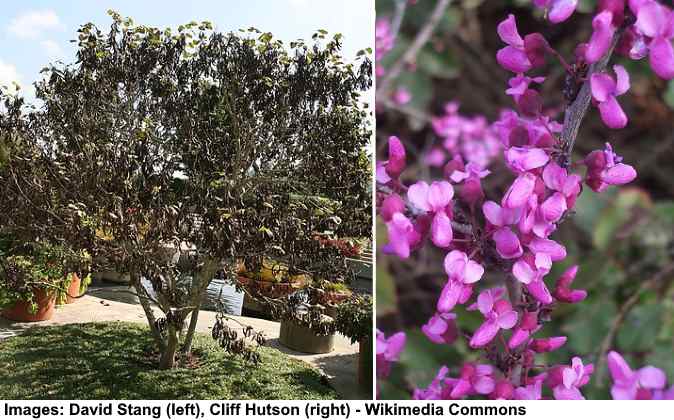
The Texas redbud is a large shrub or small tree known for its clusters of magenta-purple flowers. In early spring, these tiny flowers bloom in vivid colors, covering the bare branches until the leaves start to grow. The pink-purple flowers continue to bloom as the leaves grow, increasing the tree’s charm.
The Texas redbud tree can be recognized by its heart-shaped leaves with rounded tips as well as its abundant purple, pink, or deep reddish-purple flowers. Additionally, the tree has dark green foliage that transforms into a delightful yellow hue during the autumn season. This tree can thrive in many soil types but prefers moist, well-drained soil.
The Texas redbud tree is a perfect choice for medium-sized landscapes. Native to Texas and Oklahoma, this tree is a great ornamental addition to any garden, adding a colorful touch to urban gardens or creating a beautiful flowering border. In early spring, its breathtaking flowers create a vibrant exhibition of colors.
Mature Size: 12 to 18 ft. (3.6 – 5.5 m) tall and 10 to 15 ft. (3 – 4.5 m) wide
USDA Hardiness Zones: 6 to 9
Sun: Full sun or partial shade
Purple Glory Tree (Tibouchina granulosa)
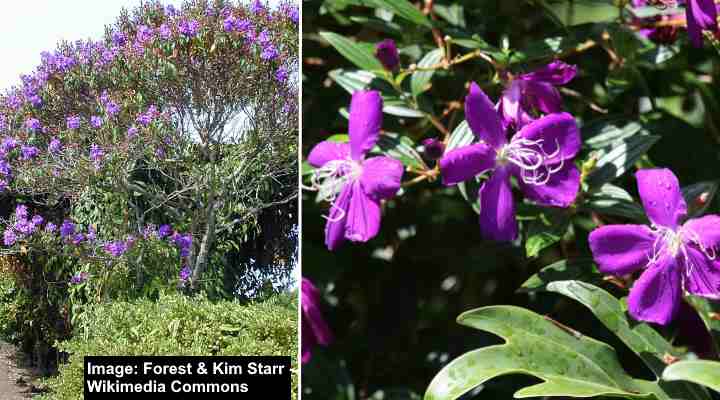
The purple glory is an attractive evergreen shrub or small tropical tree that is widely recognized for its vivid, violet-purple blooms. These beautiful flowers cover the tree’s spreading canopy, providing a year-round display of vibrant purple colors. The sizable, velvety blossoms beautifully contrast against the glossy, dark green lanceolate leaves.
The purple glory tree thrives in warm, tropical environments and favors well-drained, moist soil that is enriched with organic material. In regions with higher temperatures, this tree should be planted under some shade, as direct sun exposure may damage the leaves.
The purple glory tree is versatile, capable of being grown as a specimen tree, in mass plantings, as a hedge, or as a stunning focal point. Its adaptability makes it an ideal option for container gardening or mixed shrub borders.
Mature Size: 15 to 20 ft. (4.5 – 6 m) tall and wide
USDA Hardiness Zones: 10 and 11
Sun: Full sun to partial shade
Texas Mountain Laurel Tree (Sophora secundiflora)
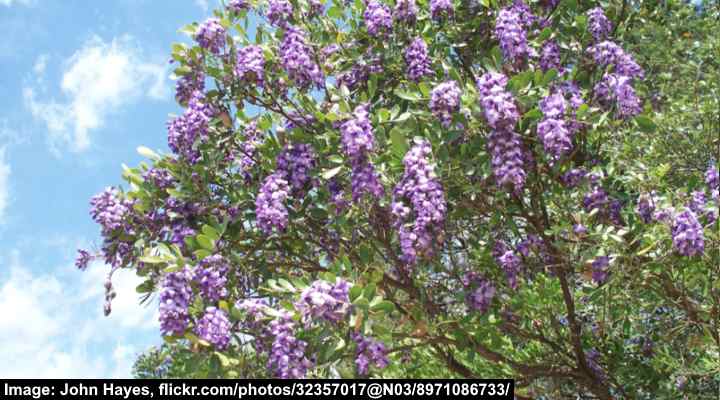
The Texas mountain laurel is a small evergreen tree recognized for its pendulous clusters of pale purple flowers. These fragrant flowers bloom in late winter or early spring, showcasing their purple-lavender hues. Hanging in large clusters, with sizes varying from 3 to 7 inches (7.5 – 18 cm), they draw in bees and butterflies, enhancing the tree’s appeal.
The Texas mountain laurel, native to south-central United States, has leathery, compound, dark green leaves that form dense foliage. This purple flowering tree is drought-tolerant and thrives in slightly alkaline, well-drained soil.
The Texas mountain laurel is an exceptional selection for xeriscape gardens, offering a captivating focal point in compact landscapes. Its evergreen foliage and beautiful purple flowers enhance the appeal of any garden setting.
Mature Size: 10 to 15 ft. (3 – 4.5 m) tall and 8 to 15 ft. (2.5 – 4.5 m) wide
USDA Hardiness Zones: 7 to 11
Sun: Full sun to partial shade
Princess Flower Tree (Tibouchina urvilleana)
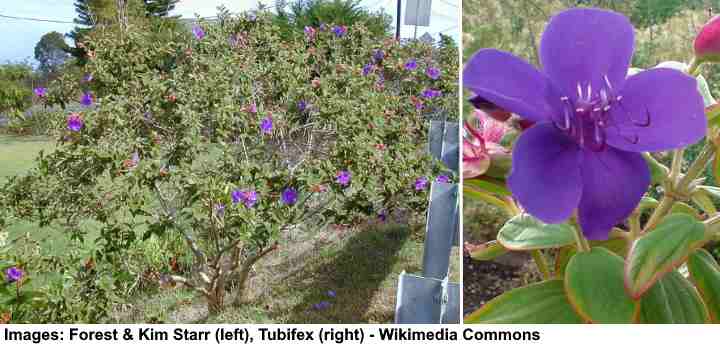
The princess flower is an evergreen shrub or small tropical tree known for its decorative, saucer-shaped purple flowers. These blooms display a deep, velvety purple color with five petals. During late summer and early fall, the tree’s vase-shaped canopy is covered with these attractive flowers, creating a stunning display.
The princess flower has glossy, dark green leaves with noticeable longitudinal veins and long, curved stamens.
When shaped into a compact tree, the princess flower can elevate the aesthetic appeal of a patio or lawn. Princess flower trees are good for creating borders, edging, container gardens, or foundation plantings. In addition, the tree attracts pollinators such as butterflies and hummingbirds.
Mature Size: 10 to 20 ft. (3 – 6 m) tall and 6 to 10 ft. (1.8 – 3 m) wide
USDA Hardiness Zones: 9 to 11
Sun: Full sun to partial shade
Purple Flowering Crabapple Trees (Malus spp.)
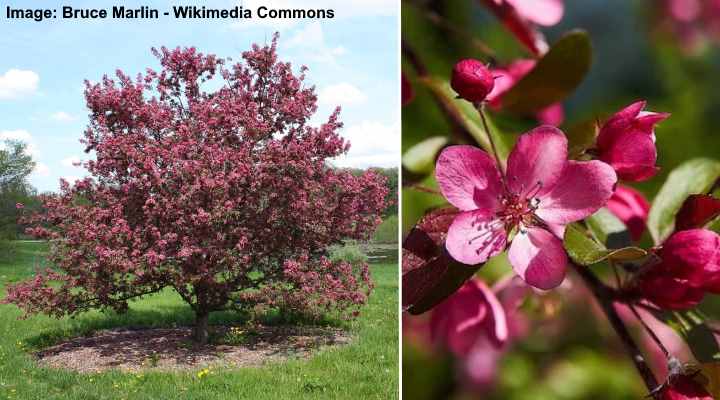
Crabapple Purple Prince (Malus ‘Purple Prince’)
Purple flowering crabapple trees are small- to medium-sized fruiting trees that have stunning purple blossoms. These trees start blooming in early spring, covering their branches with plenty of sweet-smelling flowers. Certain types of purple-flowering crabapple trees feature round, apple-like fruits and even purple leaves.
Purple-flowering crabapple trees are versatile and capable of being used in various landscaping configurations. These trees easily adapt to diverse settings, whether utilized as eye-catching standalone focal points, included in group plantings, or arranged in rows for hedging purposes. They are also tolerant of different soil types, though most prefer moist, well-draining soil.
Here are two varieties of small crabapple trees with stunning purple flowers:
Malus ‘Kelsey’: This tough crabapple variety puts on an attractive show in your garden. In the spring, it’s covered with many pretty purple-red flowers, some of them with double petals. As the seasons change, you’ll notice its leaves turn from red to bronze-green before showing off a beautiful mix of orange and yellow in the fall. This crabapple tree doesn’t take up much space and grows in an upright manner, forming a nice round shape. It reaches a height and width of about 15 to 18 ft. (4.5 – 5.4 m).
Malus ‘Purple Prince’: This deciduous, fruit-bearing tree is recognized by a rounded or slightly spreading crown and a dense, compact growth pattern. The tree’s most noticeable features are its deep purple-to-pink flowers and purple leaves. For it to do well, it needs lots of sunlight and soil that drains well. When fully grown, it reaches a height and width of about 18 to 20 ft. (5.4 – 6 m).
Purple Flowering Crape Myrtle (Lagerstroemia)

The purple flowering crape myrtle is a deciduous shrub or small tree known for its abundant blooms of bright purple flowers with ruffled petals. This tree blooms from summer through early autumn, displaying colors ranging from deep violet to lavender and pale blue.
Apart from their beautiful purple flowers, crape myrtle trees also have other attractive qualities. These trees have smooth, peeling bark, and thick, oval-shaped, glossy leaves. The leaves start out dark green in the summer and then transition into lovely shades of orange, red, or yellow in the fall.
Additionally, crape myrtles are hardy, capable of tolerating drought conditions and various soil types.
Here’s a selection of crape myrtle types with purple blossoms:
Lagerstroemia ‘Purple Magic’: This lovely crape myrtle variety displays beautiful purple flowers during the summer. It’s a fantastic choice for creating a flowering hedge, foundation planting, or privacy screen. When fully grown, the Lagerstroemia ‘Purple Magic’ tree usually reaches a height and width of 6 to 10 ft. (1.8 – 3 m).
Lagerstroemia ‘Early Bird’: This crape myrtle can be grown as a small tree or a compact shrub. It showcases bunches of vibrant purple flowers and is known for its early blooming habit. It usually stands at a height of 5 to 6 ft. (1.5 – 1.8 m) and has a width of 4 ft. (1.2 m).
Lagerstroemia ‘Infinitini Purple’: This smaller crape myrtle variety has abundant clusters of deep purple flowers that have a crinkled appearance, similar to crepe paper. It’s a perfect choice for smaller gardens, borders, or foundation planting. When fully grown, this compact shrub usually reaches a height and width of 3 to 5 ft. (1 – 1.5 m).
Lagerstroemia ‘Infinitini Orchid’: This shrub or small tree is an excellent option for limited spaces or compact gardens in your landscaping. It displays beautiful lavender or crinkled purple flowers that bloom from summer through fall, adding vibrant color to gardens, borders, or containers. When fully grown, this shrub typically measures between 2 to 4 ft. (0.6 – 1.2 m) in both width and height.
Catawba Crape Myrtle (Lagerstroemia indica ‘Catawba’): This attractive tree or medium-large shrub has purple flowers that bloom in late summer. The glossy green foliage is dense and serves as a striking backdrop for the purple flower clusters, creating a stunning contrast. When fully grown, Catawba crape myrtle trees typically reach a height and width of 10 to 15 ft. (3 – 4.5 m).
‘Royal Purple’ Smoke Tree (Cotinus coggygria ‘Royal Purple’)
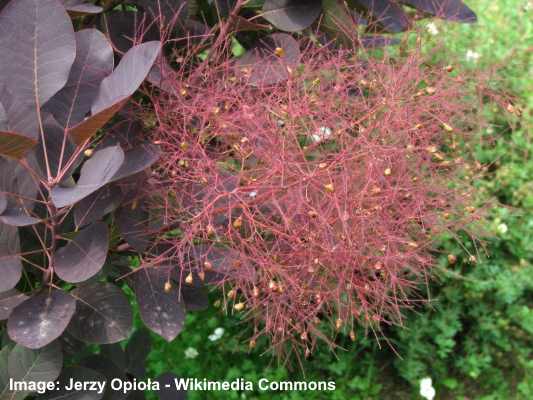
The ‘Royal Purple’ smoke tree is a sizable shrub or petite multi-stemmed tree known for its clusters of pinkish-purple plume-like flowers. Its most distinctive feature is its soft, fuzzy plumes which give it a smoke- or cloud-like appearance. These delicate flowers resemble wisps of pink, purple, or white smoke, creating a stunning spectacle in late spring or early summer.
The smoke tree has oval-shaped leaves with a deep purple hue, intensifying to a wine-purple shade during summer. When autumn arrives, the leaves transform into striking shades of red, adding to the tree’s visual appeal in any landscape.
Smoke trees are highly adaptable and can be beautiful additions to any garden. Their beautiful flowers and foliage make them versatile choices, suitable as border plants, informal hedges, privacy screens, or foundation plants.
Mature Size: 10 to 15 ft. (3 – 4.5 m) tall and 15 to 20 ft. (4.5 – 6 m) wide
USDA Hardiness Zones: 4 to 9
Sun: Full sun to partial shade
Purple Flowering Hibiscus Tree (Hibiscus syriacus ‘Purple Satin’ and ‘Azurri Blue Satin’)
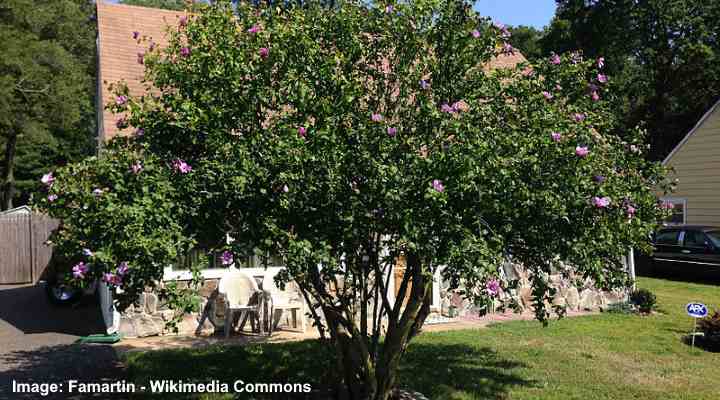
Hibiscus syriacus, commonly known as the rose of Sharon, is a flowering shrub that can also be grown as a small ornamental tree. Several hibiscus species have eye-catching and lively flowers. These beautiful blooms are often trumpet-shaped, with delicate frilly petals and a noticeable cone-like stamen.
The purple-flowering rose of Sharon varieties usually reach heights of 8 to 10 feet (2.4 to 3 meters) and can spread up to 10 feet (3 meters).
Now, let’s briefly introduce three hibiscus trees with purple flowers:
Hibiscus syriacus ‘Purple Satin’: This type of hibiscus has single flowers in a funnel shape and a deep purple color. These purple flowers bloom consistently from summer to fall, making them a great choice for planting near foundations, creating flowering hedges, or providing privacy screens.
Hibiscus syriacus ‘Azurri Blue Satin’: This variety of rose of Sharon features purple flowers with large, funnel-shaped blooms and charmingly ruffled pale purple petals. This flowering shrub or small tree is well-suited for planting at the back of borders, adding a touch of charm to the landscape.
Hibiscus syriacus ‘First Editions French Cabaret Purple’: This multi-stemmed shrub has double purple flowers that resemble carnations, making it perfect for lining foundations, forming hedges, or adding beauty to shrub borders.
Common Lilac (Syringa vulgaris)

The common lilac is a shrub-like tree characterized by its vibrant purple blossoms. This flowering tree has a bushy growth habit, with branches covered with scentful, cone-shaped clusters of purple blooms. These charming flowers bloom from late spring to early summer, forming a mesmerizing display of lilac hues while emitting a delightful scent. Lilac trees also produce beautiful flowers in hues of white, pink, or blue.
The common lilac has smooth, heart-shaped leaves that are either grayish-green or blue-green in color. With its dense and appealing foliage, this shrub-like tree is an excellent option for hedge planting, privacy screening, or as a striking standalone specimen tree. Dwarf lilac varieties can be grown in containers to add a touch of beauty to a deck, patio, or entrance. These plants are also hardy, allowing them to withstand cold weather and harsh winter conditions.
Due to their low maintenance requirements, drought tolerance, and consistent spring blooms, common lilacs have gained popularity as a favored option for ornamental planting. Additionally, their fragrant blossoms attract butterflies and bees, establishing them as a beloved choice among pollinators.
Mature Size: 8 to 10 ft. (2.4 – 3 m) tall and 5 to 6 ft. (1.5 – 1.8 m) wide
USDA Hardiness Zones: 3 to 8
Sun: Full sun for best flowering
Purple Flowering Dogwood (Cornus florida ‘Purple Glory’)

The purple flowering dogwood is a small deciduous tree or large shrub known for its bright purple, pink, and scarlet flowers. The tree’s ‘flowers’ are in fact reddish-purple bracts that appear during spring. The ‘Purple Glory’ variety stands out as an attractive ornamental choice due to its deep purple leaves, which change into a black-purple hue in the fall.
Other identifying features of the purple flowering dogwood are its rapid growth, compact size, and rounded canopy. The tree keeps its vibrant colors even in full sunlight until its leaves drop in the fall. Due to this, the purple flowering dogwood is very popular for small gardens, lawns, and patios. It can also serve as an eye-catching accent tree in larger landscapes.
The purple flowering dogwood can thrive in various soil types, such as clay, loam, and sandy soils, though it prefers moist, well-drained soil. For optimal growth, plant this tree in partial shade, although it can withstand full sun if it is adequately watered.
Mature Size: 15 to 20 ft. (4.5 – 6 m) tall and wide
USDA Hardiness Zones: 5 to 9
Sun: Partial shade
Related articles:
